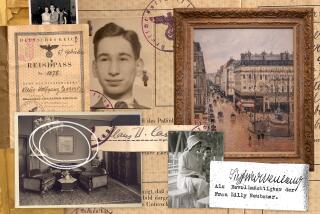Picasso sets record sale price
Some mistresses are more valuable than others. On Tuesday night, Christie’s New York sold Pablo Picasso’s bold 1932 portrait of his lover Marie-Thérèse Walter, “Nude, Green Leaves and Bust,” for $106.5 million, making it the most expensive artwork ever sold at auction.
“I think the Picasso illustrates what has been true in good and bad economic times — the very best works of art continue to sell at a premium,” said Marc Porter, chairman of Christie’s Americas. He said the nine bidders active after the opening bid of $58 million “came from all over: Asia, the U.S., and Europe, including the former Soviet republic.”
At press time, the buyer, who had placed the winning bid of $95 million (which, including buyer’s fees, amounts to $106.5 million) by telephone, was not identified.
The painting came from the estate of Frances Brody, the Los Angeles arts patron who died last year at age 93. Her husband Sidney, a real estate developer, died in 1983. The estate consigned this Picasso to Christie’s along with some 80 other artworks. The most valuable pieces, including sculptures by Alberto Giacometti, went up for auction Tuesday night; the remainder are slated for Wednesday morning.
The previous world record for a work sold at auction was held, albeit briefly, by Giacometti’s 6-foot-tall sculpture “Walking Man I.” Sotheby’s London sold the bronze earlier this year for 65 million pounds, or $104.3 million.
While a handful of paintings reportedly have changed hands privately for amounts surpassing $100 million, only one other painting has broken this ceiling at auction. It was also by Picasso.
In 2004, Sotheby’s sold “Boy With a Pipe,” the artist’s 1905 Blue Period masterpiece, for $104.2 million, including buyer’s fees. In 2006, Sotheby’s approached this benchmark with Picasso’s edgy 1941 portrait of another mistress, Dora Maar, known to be more emotionally and intellectually challenging. It sold for $95.2 million.
The Brodys originally bought “Nude, Green Leaves and Bust” in January 1951 from Paul Rosenberg’s New York gallery for $19,800 (about $166,000 in today’s dollars).
The painting is a colorful, sensual image of Walter, whom the artist had originally picked up outside the Paris department store Galeries Lafayette when she was 17. When this painting was made, she was 22 and Picasso 50.
Not like his wife
Picasso’s portraits of his wife at the time, the Russian ballerina Olga Khokhlova, are often dark in palette and relatively restrained formally. His portraits of Walter, who was blond and athletic, tend to be more exuberant, bursting with foliage and sunny colors.
He painted Walter frequently in the first months of 1932, a feverish period in which he was preparing for a retrospective at Galerie Georges Petit in Paris.
He painted her asleep in an armchair in “Le Rêve,” now owned by Steve Wynn. He depicted her looking ripe if not pregnant in “Girl Before a Mirror,” which has been in the Museum of Modern Art collection almost as long as there has been a collection.
The founding director of the MoMA, Alfred Barr Jr., once described this series of portraits as “unlike anything he had done before in their great sweeping curves, which are echoed in several paintings with philodendron leaves.”
Reached before the sale, Christie’s Impressionist/Modern art head Conor Jordan said that the significance of these related works helps to establish the importance of “Nude, Green Leaves and Bust.”
But he also thought the work stood on its own. “It’s such a spectacular painting about love, lust, obsession, possession,” Jordan added. “I haven’t shown it to anyone who has not been totally bowled over by it.” He had placed an estimate on “Nude, Green Leaves and Bust” of $70 million to $90 million.
Christie’s was literally banking on a sky-high price in one respect: It had offered the Brody estate a “guarantee,” ensuring a minimum price for some artworks regardless of outcome. The practice — really a tool for auction houses to win material away from competitors — has become less popular in the industry recently because of the economy.
“After the downturn of 2008,” Jordan said, “we said guarantees would cease to be everyday business. But we knew we would make an exception when something exceptional comes along.”
New York economist Michael Moses, who has developed indexes tracking sales at auction, calls the Brody Picasso “a good example of a wealth preserver.”
“Here is an artist who has been famous for nearly 100 years, and he’s still outperforming the rest of his market,” Moses said. “So a collector parking a lot of money into a Picasso painting feels pretty confident that he will not lose money on it.”
Will provisions
By the terms of Frances Brody’s will, a portion from the sale of her estate will go to the Huntington Library, Art Collections and Botanical Gardens, where she served on the board of overseers for 20 years.
Huntington President Steven S. Koblik said the exact amount would not be known until both Christie’s auctions are completed and the Brodys’ home in Holmby Hills, which A. Quincy Jones designed in 1949, has been sold. Linda May and Jade Mills of Coldwell Banker in Beverly Hills put the house on the market this week with a listing price of $24.95 million.
Koblik would not comment on whether Frances Brody’s will gives the Huntington a flat percentage of the house and art proceeds or uses a more elaborate formula. “I am not able to give you specific numbers,” he said, “but I can say we are a major heir.”
More to Read
The biggest entertainment stories
Get our big stories about Hollywood, film, television, music, arts, culture and more right in your inbox as soon as they publish.
You may occasionally receive promotional content from the Los Angeles Times.










